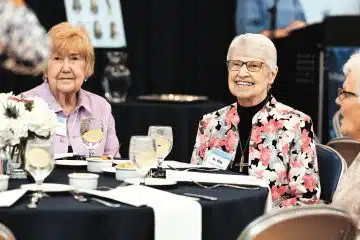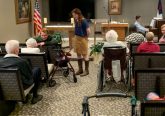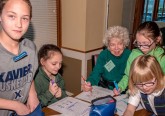Elder abuse and neglect: what faith communities need to know

By Dr. Jack Rudnick Jr.
And even when I am old and gray, O God, do not forsake me, Until I declare Thy strength to this generation, Thy power to all who are to come (Psalm 71:18).
The World Health Association reports that the world is in the throes of a demographic revolution. With the number of seniors 65 years of age predicted to rise to become 25 % of the U.S. population by 2025, according to the U.S. Census Bureau website, a likely outcome is a correlation in the rise of an emerging health and social crisis—elder abuse and neglect. This escalating global phenomenon requires awareness, education and intervention responses by the host of stakeholders affected by this disturbing presence in our communities. Elder abuse and neglect is an important concern because, as the Administration on Aging reports, an estimated 2.1 million older Americans are victims of elder abuse, neglect or exploitation annually.
This article explores a fundamental overview of elder abuse, neglect, and financial/material exploitation. The information is intended to demonstrate how seniors can protect themselves from some abuses. In addition, awareness and action suggestions will be offered for faith communities, which are positioned to play a pivotal role in responding to this emerging local as well as international human rights and public health epidemic.
Elder Abuse Defined
There is a lack of uniformity, consistency and standardization of what constitutes elder abuse worldwide. However, a general description of elder abuse is the intentional or neglectful acts by caregivers or trusted individuals that lead to harm against a vulnerable elder. (Elder, in the U.S., is typically defined as 65 years of age or older; however, the same principles, concerns and issues of protection hold true for disabled adults age 18-64.) The National Center for Elder Abuse and Neglect (NCEA) broadly classifies three abuse domain categories: domestic, institutional and self-neglect. Domestic abuse is a form of maltreatment that occurs in the home of the elder or caregiver. Institutional abuse refers to mistreament when care is provided in a nursing home, group home, or board and care facilities. Self-neglect is the behavior of an older person that poses a threat to his or her own safety such as failing to address basic health and safety needs—food, water, clothing, medications and personal hygiene.
Patterns of elder abuse and neglect have been collected and research on this topic has been growing. But it was only in 1987 in the United States that the NCEA reported federal definitions of the abuse, neglect and exploitation of seniors in the Amendments to Older Americans Act. Dr. Pamela Teaster, Professor at the University of Kentucky’s Center on Aging, notes that from an awareness viewpoint, “…elder abuse is where child abuse was 20 years ago.”
Types of Abuse
The NCEA developed the following descriptions of the seven types of abuse:
Physical Abuse: Use of force to threaten or physically injure a person.
Emotional (Psychological) Abuse: Verbal attacks, threats, rejection, isolation, or belittling acts that cause or could cause mental anguish, pain, and distress to a senior.
Financial and Material Exploitation: Theft, fraud, misuse or neglect of authority and use of undue influence to lever or gain control over an older person’s money or property.
Neglect: A caregiver’s failure or refusal to provide for a vulnerable elder’s safety, physical or emotional needs.
Abandonment: Desertion of a frail or vulnerable elder by anyone with with a duty to care.
Self–Neglect: An ability to understand the consequences of one’s own actions or inaction, which leads to or may lead to harm or endangerment.
Sexual Abuse: Forced, tricked, threatened or otherwise coerced sexual contact upon an elder, including anyone who is unable to grant consent.
Reporting: The Iceberg Theory
One of the challenges associated with elder abuse reporting is that only an estimated 18 %, or one in five cases, is reported. This is what has come to be known as the ‘iceberg theory.” The prevalence of elder abuse is primarily weighted in the neglect and self-neglect categories, which comprises approximately 53% of all abuses reported. The least prevalent reported abuse type is sexual abuse (2%). Currently, the incidence of reporting (i.e. newly reported cases) falls into the fastest rising abuse form—the financial abuse and material exploitation category. While there are no known cumulative research studies on this topic, professionals in the field assert that women tend to commit more physical abuse because they are frequently the caregiver and have more contact with an elder; while men are likely to be guilty, more often, of financial and material exploitation as compared with women due to the nature and patterns of men’s behavior relative to “expensive hobbies.”
Risk Factors
Perpetrators are typically adult-family members including sons, daughters, grandchildren and spouses. They may have issues including the following: gambling problems; standing to inherit the elder’s estate and want may be rightfully theirs prematurely; or having negative family relationships with either the elder or siblings. Poor family dynamics is typically at the root-cause of elder abuse and neglect. While caregiver stress may be a contributing factor, this is typically not the main reason for most elder abuse. As seniors age, the risk for abuse increases—those over 80 and or with dementia are at increased risk. In addition, gender, social isolation, living under the same roof with family, and poor physical health increase vulnerability.
There are strategies for seniors to protect themselves from abuse, neglect and exploitation:
-Be cautious. Learn about the types of elder abuse and neglect and associated warning signs.
-Get your estate plan in order with a trusted attorney;
-When hiring someone for personal assistance services, check that he or she has been properly screened and that criminal background checks are completed
-Learn about options for long-term care if it becomes necessary;
-Do not provide any personal information over the phone unless you placed the call and know with whom you are speaking.
Strategies for Faith Community Consideration
Faith communities are trusted places for seniors to come together as part of a cohesive community for worship. Environments are intended to be welcoming and safe. Many, if not the majority of some faith congregations, are themselves seniors. Prevention is preferable to a situation where intervention is necessary. Faith members need to show concern for fellow members. When someone has not been seen in church or in the community for some time, it may be both prudent and our Christian duty to inquire about the well being of that person. Here are some suggestions for further improving the worship environment and for becoming more elder-friendly:
-Become aware of the signs and symptoms of elder abuse and neglect (see www.ncea.aoa.gov);
-Report suspicions of elder abuse –it is both a moral responsibility and, in Kentucky as in most states, a legal duty;
-Act–if there is imminent danger to a senior, one should contact law enforcement or call 911, immediately. Otherwise, all mistreatment to elders should be reported to Adult Protective Services. In Kentucky the contact information to report elder abuse is: 1-800-752-6200
-Keep in contact with older friends, neighbors and relatives frequently.
Maintain ongoing vigilance–become a sentinel and watch out for the possibilities of abuse.
-Ask questions and listen when necessary
Together, with a more concerted effort on elder abuse prevention and knowledge concerning appropriate responses to abuse suspicion, risk factors can be minimized and the problems associated with abuse ameliorated. Seniors need to find comfort and peace in faith communities as a spiritual and trusted haven for retreat and worship
Rudnick, a parishioner at St. Joseph, Cold Spring, Ky., serves an associate professor for business administration and Healthcare management at Thomas More College. He has authored several professional journal articles on this topic including a book, Elder Abuse and Neglect: Clergy Awareness, Knowledge and Intervention.












